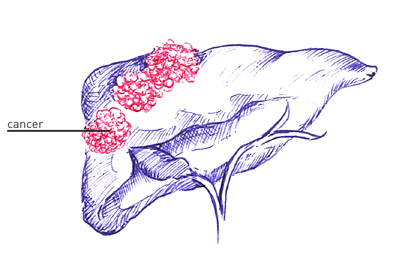The Reality of Liver Cancer
Liver cancer, also known as hepatic cancer, activates in the cells of your liver, which is a football-sized organ that sits in the upper right portion of your abdomen, beneath your diaphragm and above your stomach. Malignant cells that develop in the normal cells of the liver (hepatocytes) are called hepatocellular carcinoma.

REALITY CHECK
There were 605 cases of liver cancer diagnosed in 2007 and reported to the Malaysian National Cancer Registry, comprising of 443 males and 162 females. The incidence of liver cancer increases with age and are higher in males compared to females. The Chinese were found to have a higher incidence rate compared to Malay and Indian races.
Common Types of Liver Cancer
HEPATOCELLULAR CARCINOMA (HCC)
HCC begins in the main type of liver cells, called hepatocellular cells. Also called hepatoma, it is the most common type of liver cancer, accounting to approximately 75 percent of all liver cancers.
CHOLANGIOCARCINOMA
A type of bile duct cancer, it occurs in the small, tube-like bile ducts within the liver that transfers bile to the gallbladder. Cholangiocarcinoma cases account for 10 – 20 percent of all liver cancers. There are two subtypes of cholangiocarcinoma: intrahepatic bile duct cancer which begins in ducts within the liver, and extrahepatic bile duct cancer that develops in ducts outside the liver.
ANGIOSARCOMA
Angiosarcoma, also called hemangiocarcinoma, begins in the blood vessels of the liver and develops quickly. The speedy growth is often the reason why they are typically diagnosed at an advanced stage. Angiosarcoma cases account for about 1 percent of all liver cancers.
FIBROLAMELLAR HCC
Fibrolamellar HCC is a rare type of HCC that is often more responsive to the treatment of other types of liver cancer.
SECONDARY LIVER CANCER
When primary cancer from one part of the body starts spreading to the liver, that means secondary liver cancer has been developed. This occurrence is also known as metastasis and it usually begins with colorectal cancer. More than half of the cancer cases that were diagnosed with colorectal cancer eventually develop secondary liver cancer.
Staging and Grading
Once you have been diagnosed positive for cancer after a biopsy test, the condition will be given a stage and grade. This vital information will help you and your healthcare team to choose the best treatment for you. The cancer stage will describe the size of the tumour and how far it has spread.
There are 4 stages for liver cancer:
Stage 1
- There is a single tumour that has not spread to the blood vessels, lymph nodes or any other part of the body
Stage 2
- A single primary tumour, or several small tumours, all less than 5cm in diameter have grown into the blood vessels
- The cancer has not spread to nearby lymph nodes or any other part of the body
Stage 3
- Stage III liver cancer is divided to 3 subcategories:
Stage III A: There are several tumours and at least one is larger than 5cm. The cancer has not spread to nearby lymph nodes or any other part of the body.
Stage III B: The cancer has grown into one of the main blood vessels of the liver, but cancer cells have not spread into the lymph nodes or to any other part of the body.
Stage III C: The cancer has spread into organs close to the liver, or the tumour has grown into the outer covering of the liver. The cancer has not spread to nearby lymph nodes or to any other part of the body.
Stage 4
- The cancer has been spread to nearby lymph nodes and may have grown into nearby blood vessels or organs
- Advanced liver cancer does not often spread to distant organs, but when it does, it is most likely to spread to the lungs and bones
There are 3 grades of liver cancer:
Grade 1 – It is low grade, and the cancer cells look very much like normal liver cells.
Grade 2 – It is an intermediate grade, and the cancer cells look slightly like normal liver cells.
Grade 3 – It is high grade, and the cancer cells look very abnormal.
WARNING SIGNS
- Hepatomegaly – enlarged liver, the abdomen might appear swollen
- Jaundice – skin, tongue and whites of the eyes become yellow
- Abdominal pain – often on the right side, and may reach as high up as the shoulder
- Unknown reasons of weight loss
- Fatigue
- Nausea and emesis (vomiting)
- Back pain
- General itching
- Fever
AM I AT RISK?
Yes, even more so with these factors:
- Heavy use of alcohol
- Smoking habit
- Exposure to arsenic and chemicals
- Harbour the Hepatitis B (HBV) or Hepatitis C virus (HCV)
- Obesity
THERE ARE RISK FACTORS THAT CAN'T BE CHANGED:
- Age
- Gender and ethnicity
- Family history
- Inherited metabolic disease
- Diabetes
WHAT CAN I DO?
Beat the cancer. Cut your risk by taking these steps:
- Do not smoke
- Limit alcohol intake
- Do not use intravenous (IV) drug, unless under the supervision of healthcare professional
- Maintain a balanced body weight
- Quit smoking
- Get HPV vaccination
Liver Cancer Myths Vs Facts
Myth |
Fact |
| Liver disease is a result of alcoholism | Alcohol is only one of the causes of over 100 forms of liver disease. |
| Only adults will get liver disease | Children are also affected. Major causes of liver disease in children include genetics, viruses (Hepatitis A, B, C) and a blocked flow of bile from the liver. In addition, obese children are at high risk of developing a fatty liver. |






